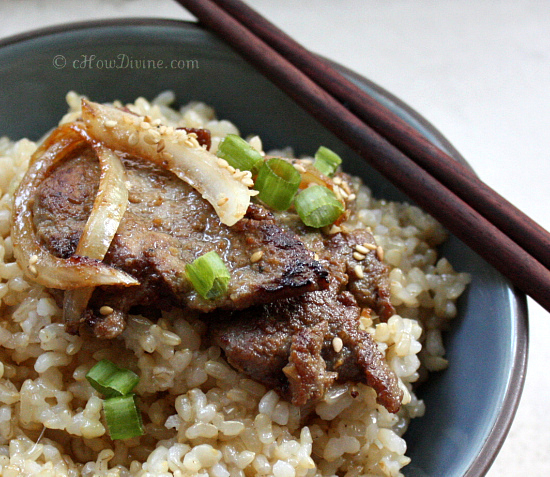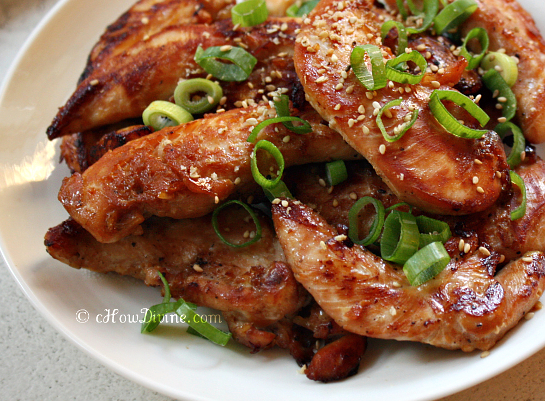 My cold has gotten a lot better, almost gone actually. But it was a nasty one. So I didn’t want to take any chances. What better way to oust it from my system than nourishing my body with a delicious hearty traditional Korean soup? As such, my husband and I went on a quest to find samgyetang (soup with whole young chicken stuffed with glutinous rice, ginseng, and jujubes) in Koreatown (NYC).
My cold has gotten a lot better, almost gone actually. But it was a nasty one. So I didn’t want to take any chances. What better way to oust it from my system than nourishing my body with a delicious hearty traditional Korean soup? As such, my husband and I went on a quest to find samgyetang (soup with whole young chicken stuffed with glutinous rice, ginseng, and jujubes) in Koreatown (NYC).
Bulgogi (Korean Beef Barbecue)
I grew up eating bulgogi (a.k.a. Korean BBQ or Korean Barbecue) on a regular basis. It was a mainstay at family dinners, picnics, community gatherings, and so on. Sometimes we would barbecue bulgogi using charcoal. Sometimes we would cook it on a stove top using a pan. And other times, we would eat it as a stew with a little bit of broth. No matter the situation or the method of preparation, it was always so delicious and satisfying.
Admittedly, I don’t eat bulgogi nearly as much I used to. But I still enjoy it whenever I have it. I am also a little more health conscious than I used to be. So I no longer go on the carnivorous binges I used to. And I try to make healthier versions of my childhood dishes without sacrificing the taste.
Bulgogi is usually made with very thinly-sliced rib eye steak. But I decided to make a healthier(not to mention much more economical) version of the dish by using grass-fed eye round steak. Eye round is a much leaner cut than rib eye. Rib eye comes from the underbelly, the site of the fattiest cuts. And the eye round comes from the back leg area, the site of the leanest cuts; however, eye round can be very tough because it has virtually no fat. But it works for this dish because the eye round is cut into very thin slices and also marinated. Just as insurance, I am also adding a kiwi to tenderize the meat. Raw kiwi is rich in actinidin, a protein-dissolving enzyme. Useful as it is, kiwis can make meat mushy. So you need to be careful when using it in a marinade. A little goes a long way (very quickly).
I’ve been laid out by a cold for over a week. And I’ve been subsisting on soups to nurse my sore throat. When I was finally ready to reintroduce some solids into my diet, bulgogi seemed like the perfect choice. I figured lean protein and the iron should do me some good while the flavor satisfies my taste buds. And it really hit the spot. I was so pleasantly surprised by the texture and the taste of this dish. It was healthy and tasted so very decadent.
Miyeok Guk for the Soul (Korean Seaweed Soup)
Growing up, I didn’t get chicken noodle soup for colds and other ailments. I got Miyeok Guk, sometimes Samgaetang (soup with cornish game hen stuffed with sweet rice), but mostly Miyeok Guk.
Miyeok (seaweed) is rich in minerals and phytonutrients that are beneficial to the human body. In fact, Miyeok Guk is served in hospitals in Korea to postpartum women to replenish nutrients that may have been depleted during childbirth; and they continue to consume the soup during lactation due to its properties that are believed to stimulate lactation. So it’s apropos that it is traditionally served on birthdays as symbolism for the first food consumed after birth. But Miyeok Guk is not reserved for these occasions alone. It is consumed all year round due to its health benefits and deliciously savory flavor.
If that doesn’t convince you to give this soup a try, I read an article the other day about 5 nutrients that people are not getting enough of. One of the nutrients mentioned is iodine. Many believe that iodine intake from the contents of their salt shaker would suffice, but this article suggests otherwise. Iodine is required to produce hormones that control your metabolism; so deficiency in iodine may cause weight gain, and according to the article, fatigue. Miyeok is a type of sea vegetable. And sea vegetables are an excellent source of iodine.
It’s a good thing that Miyeok Guk is so healthy. Because I have been under the weather lately. It must be the change in the weather. The huge fluctuations in temperature and humidity level really messes with my system. So I’ve been sniffly and feeling really weak. And my pounding head, my sinuses and my throat have been keeping me awake at night. ugh… the dreaded cold.
I decided to make Miyeok Guk. It’s pretty easy to make. It’s nourishing for the body (and the soul). It’s soothing. It’s tasty. And it takes me to a happy place.
Korean Soy-Marinated Chicken
This is one of my favorite ways to prepare boneless, skinless chicken breasts. They’re moist, tender, and, more importantly, so flavorful. If you are familiar with Korean cuisine, the chicken breasts are marinated in a bulgogi-like marinade. It has the right amount of salty and sweet to make it the perfect accompaniment to plain steamed rice.
Some people may believe that they need to resign themselves to dry and/or tough boneless chicken breasts. They are healthy, in part, due to their low fat content, but this also causes them to be dry and tough if not cooked correctly. So by marinating the chicken breasts in a soy sauce-based marinade, you are effectively soaking them in a brine solution; this makes the chicken breasts juicy. Now I really want to break into a discussion about osmosis and osmotic pressure – some of the science behind why brining works the way it does. But I will suppress the urge, lest I bore you to death and give myself away as a giant science geek.
Believe me though, this dish is extremely juicy and flavorful.
Nokdu Bindaetteok (Mung Bean Pancakes with Dipping Sauce)
Nokdu Bindaetteok (Korean Mung Bean Pancakes) is my maternal grandmother’s specialty. Nokdu Bindaetteok, which directly translates to Mung Bean Pancake, is usually made with sliced pork, kimchi, sukju namul (mung bean sprouts), and sometimes gosari namul (bracken fern shoots). But I’m omitting the pork for this Nokdu Bindaetteok/Mung Bean Pancake recipe, making this dish vegan. And for the base of the batter? Simply, soaked mung beans and rice. Flour-free. Gluten-free. Dairy-free. Just delicious goodness.
Keep in mind; when you dine at a restaurant, mung bean pancakes are not necessarily gluten-free unless specifically stated. Restaurants can add different types of flour to the batter – not a good thing. Additionally, dipping sauces can contain gluten. So always ask. Don’t assume.
Happy Eating!






